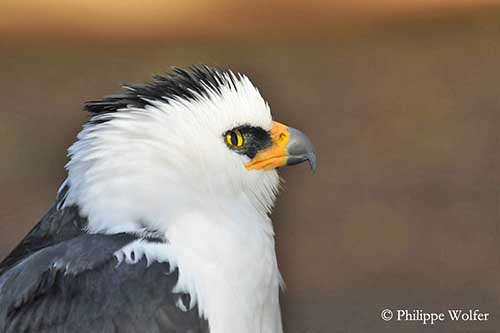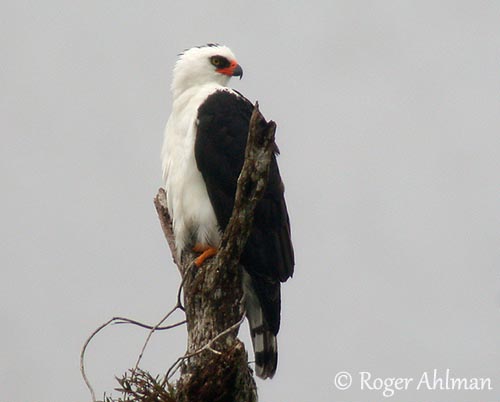
Fr: Aigle noir et blanc
Ang: Black-and-white Hawk-Eagle
All: Elsteradler
Esp: Águila-azor Blanquinegra
Ita: Spizastore bianco e nero
Nd: Zwart-witte Kuifarend
Sd: Svartvit hökörn
Port: Gavião-pato
Photographers:
Roger Ahlman
Pbase Galleries Peru and Ecuador
Didier Buysse
Vision d’Oiseaux
Philippe et Aline Wolfer
OISEAUX D’ARGENTINE
Text by Nicole Bouglouan
Sources:
HANDBOOK OF THE BIRDS OF THE WORLD Vol 2 by Josep del Hoyo-Andrew Elliot-Jordi Sargatal - Lynx Edicions - ISBN: 8487334156
L’ENCYCLOPEDIE MONDIALE DES OISEAUX - Dr Christopher M. Perrins - BORDAS - ISBN: 2040185607
BirdLife International (BirdLife International)
Neotropical Birds – Cornell Lab of Ornithology
Wikipedia, the free encyclopaedia
Neotropical Raptor Network (NRN)
Black-and-white Hawk-Eagle
Spizaetus melanoleucus
Accipitrifomres Order – Accipitridae Family
INTRODUCTION:
This small raptor is a South American species. It occurs in a variety of lowland mixed forests and shrubland with extensive closed-canopy areas where it can nest.
DESCRIPTION OF THE BRID:
Biometrics:
Length: 56-61 cm
Wingspan: 117 cm
Weight: 850 g
The adult has black upperparts. The wings are blackish-brown. The tail is brownish-grey with four black bands and narrow white tip.
The underparts are pure white, including the underwing coverts. There is a broad white leading edge on the inner part of the wing, and a narrow white trailing edge. Flight feathers and rectrices are barred black.
On the white head, there are a contrasting black crown patch and a short occipital black crest. The neck is white.
The bill is blackish with orange cere. The eyes are light yellow. Lores are black, like the narrow mask around the eyes. Legs and feet are bright yellow with black talons.
Both sexes have similar plumage but the female is larger than male.

The juvenile shows white-tipped lesser and median upperwing-coverts, and the black back is washed brownish-grey. The tail bands are narrower.
On the head, the black crown patch shows white-tipped feathers. The eyes are duller yellow and the cere is pale orange.
RANGE:
The Black-and-white Hawk-Eagle has wide range in tropical America, from southern Mexico to northern Argentina. In South America, the species is found from Colombia and E Peru, and N and E Bolivia to Paraguay, N Argentina and S Brazil, and E through Venezuela to the Guianas, and then, S to C Brazil.
HABITAT:
The Black-and-white Hawk-Eagle usually frequents lowland forests, a variety of forest types such as tropical rainforest and deciduous forests.
It can be found along streams, and may hunt over shrubland too. However, it nests in closed-canopy stands in forest.
This species is usually seen up to 1000-1700 metres of elevation, and rarely higher. But in Costa Rica, it occasionally occurs up to 3000 metres while wandering.
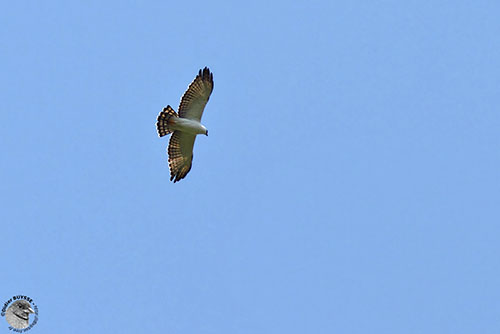
CALLS AND SONGS: SOUNDS BY XENO-CANTO
The Black-and-white Hawk-Eagle utters rising piercing whistled notes, falling in pitch towards the end “wheee-ah”. It may produce the same type of calls in longer series “kleeah-kleeah-kleeah-kle-kle”.
BEHAVIOUR IN THE WILD:
The Black-and-white Hawk-Eagle feeds on small and medium-sized birds and mammals, but its diet also includes amphibians and reptiles. Among the different bird species killed by this raptor, we can find caciques, araçaris, tinamous and chachalacas. It catches tanagers and cotingas while they are feeding on fruiting trees, and it is also able to kill cormorants while flying along streams. It has been reported attacking groups of monkeys, but actually, it does not eat them.
The Black-and-white Hawk-Eagle hunts by soaring at great heights. Once the prey is detected, it dives rapidly on folded wings and stoops onto the victim. It usually hunts at forest edges or ridges where it can use the soar-and-stoop behaviour.
It is usually seen alone outside the breeding season.
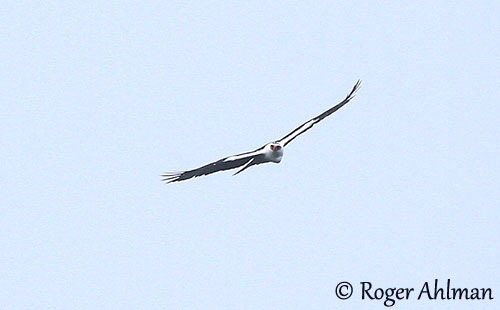
The breeding behaviour of this eagle is poorly known. From observations, the male gives repeated high-pitched scream.
The courtship displays are unknown, but they probably are fairly similar to those of other eagles of genus Spizaetus with both mates flying together and acrobatic flight displays.
There is no information about migrations or movements. This raptor is usually uncommon anywhere in its range. But as this species uses a variety of habitat types where it can find sufficient food resources, it is probably resident in its range.
Its flight is powerful and agile, especially while hunting and displaying.
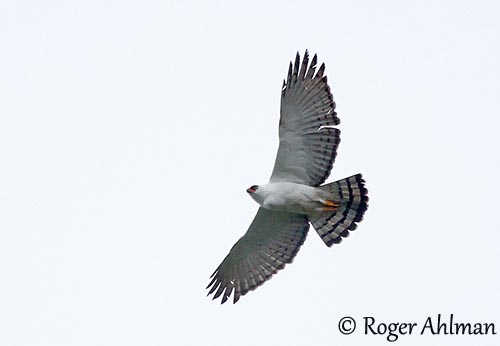
REPRODUCTION OF THIS SPECIES:
The male is in breeding condition in March in Belize, and a pair started to build a nest in September in Panama.
The breeding season may start before the onset of the rainy season. However, from an observation, the nest-building is abandoned if heavy rains occur. In Central America, the nesting season seems to occur between March and June or so.
The Black-and-white Hawk-Eagle nests in the forest canopy. The stick nest is placed in exposed trees on ridges or locations with good view on the surroundings for hunting, usually over forest and open country. The nest is often fairly high above the ground, up to 40 metres.
The eagles of genus Spizaetus usually lay a single egg. Incubation lasts 40-48 days, mainly by female, but the male feeds her during this period. The chick is fed by the female with the preys brought at nest by the male. The young eagle fledges between 65 and 95 days after hatching, but it still depends on adults for food for several months.
This eagle usually breeds every 2-3 years.
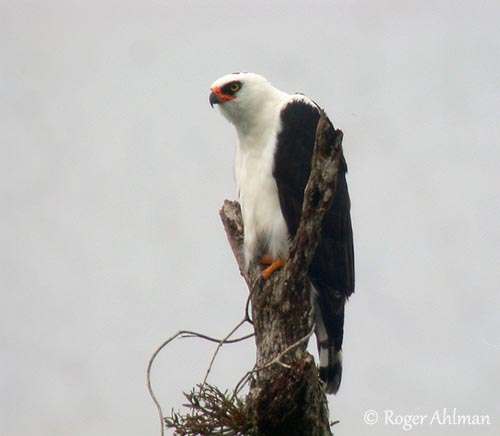
PROTECTION / THREATS / STATUS:
The Black-and-white Hawk-Eagle has wide range, but this species is not very common. It is rare in Mexico and Central America, but commoner in South America and especially in French Guiana.
The global population is unknown but it is suspected to be declining due to destruction of the habitat and human disturbances.
Currently, the Black-and-white Hawk-Eagle is evaluated as Least Concern, but this classification might be different according to each region or country.
